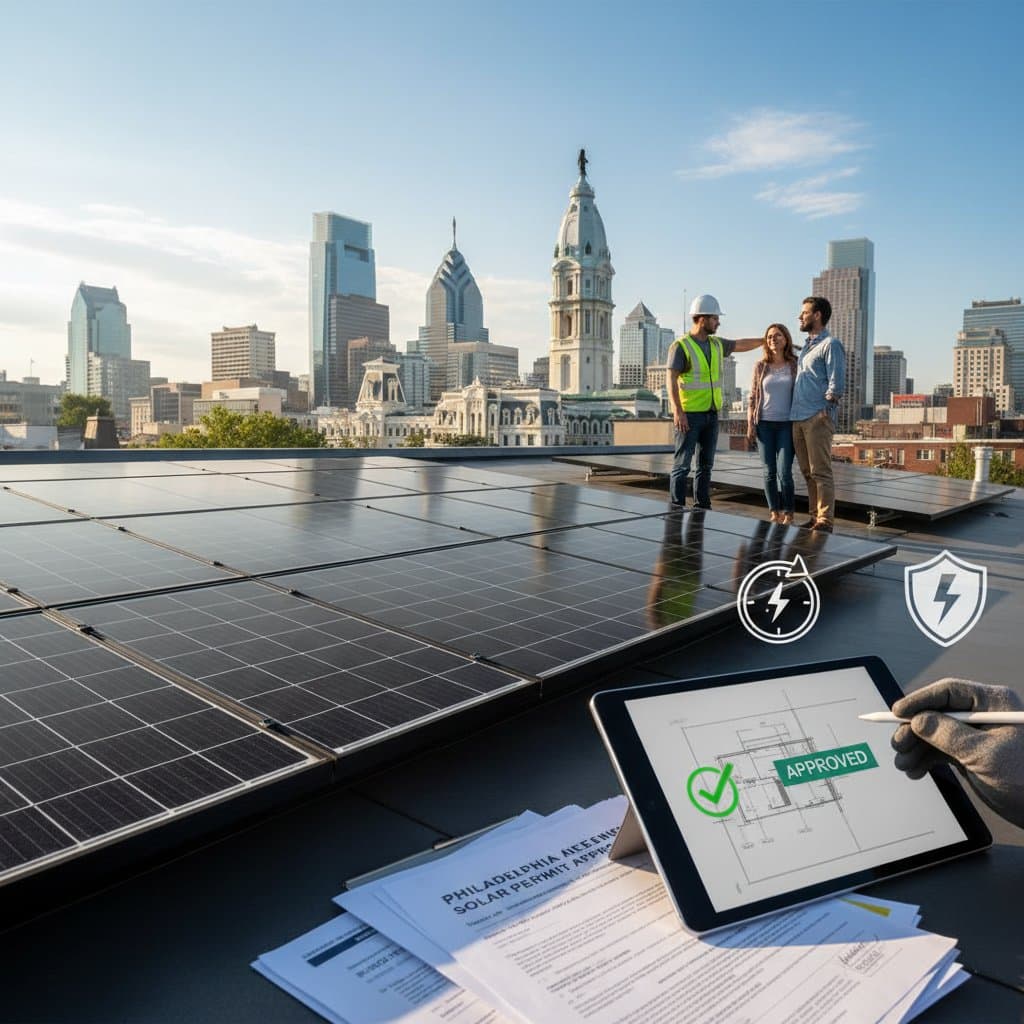Cut DIY Solar Wait Times with New Fast-Track Rules
Homeowners across Philadelphia seek to install solar power on their roofs, yet many encounter significant permit delays. The new fast-track rules for residential solar installations address this challenge. These procedures streamline reviews, minimize paperwork, and facilitate safe, code-compliant setups. The primary aim involves reducing the interval between design approval and system activation, all while upholding electrical safety standards.
This guide details the fast-track process, outlines homeowner responsibilities, and identifies moments to consult a licensed electrician or solar installer. Each step emphasizes safety, compliance with codes, and practical expectations for homeowners.
What Changed with the Fast-Track Rules
The fast-track process incorporates standardized application templates, electronic submissions, and predefined review criteria for small residential systems. Installations meeting precise conditions now receive automatic or near-automatic approval.
Key Eligibility Requirements
To qualify for fast-track review, a solar system must satisfy these criteria:
- Total capacity remains below the threshold established by local code.
- Connection occurs to a single-family dwelling, townhouse, or duplex.
- The inverter carries listing under UL 1741 standards and complies with National Electrical Code requirements.
- A line diagram illustrates no battery storage or grid export exceeding the service rating.
- Installation proceeds by a licensed electrician or a homeowner under an approved homeowner electrical permit.
When all conditions align, review times decrease substantially. Numerous applications secure decisions within several days of electronic submission.
What Remains Unchanged
The fast-track program preserves all inspections and safety verifications. Every system undergoes:
- Verification of conductor sizing and overcurrent protection.
- Grounding and bonding inspection.
- Roof load verification for roof-mounted panels.
- Final connection approval from the utility.
Fast-track status accelerates paperwork processing alone, without altering inspection thoroughness.
Step-by-Step: How to Use the Fast-Track System
Step 1: Confirm Eligibility
Prior to purchasing equipment, consult the local permit office or authority having jurisdiction. Municipalities often provide checklists for fast-track solar applications. Verify that system size, inverter type, and property type align with the criteria.
Step 2: Prepare Accurate Documents
Assemble these essential items:
- One-line diagram depicting inverter, disconnects, and service tie-in.
- Roof layout including module count, tilt, and mounting details.
- Structural letter or checklist affirming roof support capacity.
- Cut sheets for key components, such as inverters and racking.
- Completed application form, signed by the homeowner or licensed installer.
Apply clear labeling to each breaker, disconnect, and equipment enclosure. Steer clear of abbreviations that could confuse inspectors.
Step 3: Submit Electronically
Fast-track applications typically accept submissions via an online portal. Upload required files in PDF format. The system generates a tracking number and estimates review duration.
Step 4: Respond Quickly to Comments
Should reviewers request clarification, reply on the same business day. Fast-track efficiency relies on swift communication. Delays often stem from tardy responses.
Step 5: Schedule Inspection
Upon approval, arrange an inspection through the portal. Inspectors examine conductor terminations, grounding, labeling, and roof attachments. Ensure covers remain removed and equipment accessible upon arrival. Prepare a torque screwdriver and non-contact voltage tester.
Step 6: Obtain Utility Interconnection Approval
Following a passed inspection, provide proof to the utility. The utility confirms compliance of the inverter and service connection with interconnection standards. Approval grants permission to operate the system.
What the Fast-Track Rules Mean for Homeowners
The fast-track program delivers tangible advantages to homeowners. It diminishes uncertainty, accelerates timelines, and curbs indirect costs. Safety standards endure unchanged, with rigorous inspections intact.
Time Savings
The principal benefit arises from expedited paperwork. Homeowners frequently obtain permit approval in a fraction of prior durations. This advancement averts installer scheduling issues and mitigates weather-related installation delays.
Cost Control
Each day of delay incurs additional labor or financing expenses. Accelerated approvals enable homeowners to secure equipment prices and contractor schedules more effectively.
Transparency
Online tracking of application status becomes available. Automated notifications eliminate frequent phone inquiries or office visits.
Why Electrical Safety Still Defines Solar Success
Solar power reliability hinges on proper wiring and grounding. A loose lug or undersized conductor risks overheating. The National Fire Protection Association identifies faulty electrical connections as a frequent source of residential fires. Fast-track permits streamline approvals for safe systems but do not mitigate inherent risks.
In DIY solar projects, regard every electrical joint as vital to safety. Employ a torque screwdriver to meet manufacturer specifications. Label disconnects prominently. Retain records of components, including inverter serial numbers and wire connector listings.
Inspectors cannot access concealed areas behind walls or within attic conduits. Certain inspections omit internal wire condition assessments. Only a licensed electrician ensures complete verification of insulation integrity and conductor bonding.
Next Steps for Homeowners
Consider these essential points:
- All fast-track projects necessitate inspection and utility approval.
- Avoid bypassing or altering electrical equipment to hasten installation.
- Retain copies of signed documents for ongoing reference.
- Schedule inspections solely when the system stands complete and safe for energization.
These measures safeguard project success and compliance.
